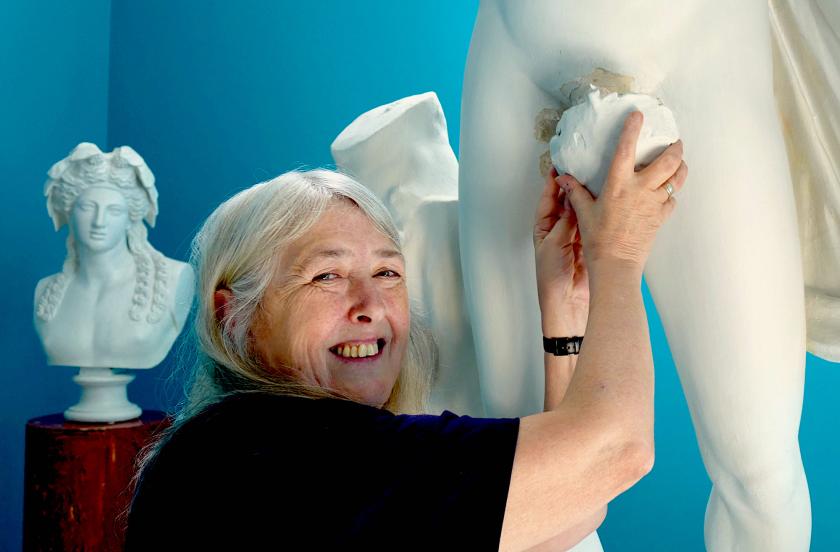Are you a fan of oysters or Marmite? Mary Beard is not to everybody’s taste, but love her or loathe her she is not only a distinguished academic but a ubiquitous writer and presenter of classical histories, connected travels, and ruminations on societal problems. She is enthusiastic, staggeringly energetic, erudite, profoundly knowledgable, the antithesis of fashionable in both opinion and appearance.
Surprisingly, this survey (on BBC Two) of representations of the nude in Western art was unusually bland, at times banal, even though our presenter obviously set out to be provoking. There are a lot of ancient bodies in ancient art, causing trouble even now, she asserted. A startling anecdote made her point.
The nude statues which are paraded through the vast corridors in the Capitoline were totally covered up in individual more-than-life-size white boxes during the visit of the Iranian president Hassan Rouhani in 2016. Closer to home, there was a stimulating intervention by the artist Sonia Boyce in Manchester’s City Art Gallery which took down (temporarily) Waterhouse’s painting Hylas and the Nymphs (those nymphs certainly looked underage) as offensive to women on various levels: females as playthings for a dominant male.
The journey began in a huge collection of white plaster replicas of antiquities: the depiction of the nude was initiated in Ancient Greece, sixth century BCE for men, century fourth century BCE for women.
We paused for Aphrodite in Greek (Venus to the Romans), actually more a sex goddess than a love goddess. And here is the fable: Praxiteles is credited with the first full-size sculpture of a naked woman in the Greek world, so lively that she came to life. Mary Beard did not remind us, though, that the white statues of antiquity we were so entranced by were originally painted.
 Leap forward a millennium or so for more: Titian’s Venus of Urino (1538 Florence) and the Venus de Medici in Florence’s Uffizi in the room known as the Tribuna. Here the lady in question is reclining, her hand over her pudenda; was she possibly… playing with herself? It is thought to be a marriage portrait; the charming dog symbolised fidelity. And the female orgasm evidently was, in the Renaissance, thought to assist fertility. We did not get to see Botticelli’s Venus on the half shell, though.
Leap forward a millennium or so for more: Titian’s Venus of Urino (1538 Florence) and the Venus de Medici in Florence’s Uffizi in the room known as the Tribuna. Here the lady in question is reclining, her hand over her pudenda; was she possibly… playing with herself? It is thought to be a marriage portrait; the charming dog symbolised fidelity. And the female orgasm evidently was, in the Renaissance, thought to assist fertility. We did not get to see Botticelli’s Venus on the half shell, though.
Beard was wickedly witty in her closely detailed examination of Zoffany’s 1772-3 The Tribuna of the Uffizi. We were shown a jam-packed crowd of visiting British grand tourists examining – with a variety of expressions from lustful and prurient to awed and innocent – the Uffizi’s display of seemingly endless painted flesh, mostly of them female but with a few male. Many an apparent heterosexual was gazing at the female bottoms on view, but some had their looks directed elsewhere.
Susannah and the Elders was a favourite Renaissance subject: sexual virtue preserved, as Susanna, bathing naked in a pool, repudiated the spying middle-aged male predators, spiting their attempted blackmail. Here we looked at Artemisia Gentileschi's 1620s version (she painted three) in the collection of Burghley House, painted about a decade after she herself was raped by her teacher.
In Florence a copy of Michelangelo’s David stands in the exact spot in which the original was shown 400 years ago. His prominent genitalia, though, were covered up just a little when first publicly shown, although now you can gaze in wonder. The discussion of the fig leaf in both painting and sculpture was quietly hilarious. Sainthood also provided a pretext: hence St Sebastian, looked at with appreciation by all genders.
We climaxed (sorry) with perhaps the most shocking and unexpected image – Courbet’s relatively small painting of 1866, The Origin of the World, in the Musée d’Orsay. A woman’s thighs are splayed, her vulva on display, crowned by pubic hair painstakingly depicted. The torso is opulent but headless. Art meeting erotica is a paradox, Beard suggests: where does art end and pornography begin – a subject for another time?
There was a glimmer of an even more fascinating subject: Beard suggested that the West fetishised the nude, making of it an object of desire, whilst other cultures were more accepting, with the human figure integrated into all forms of representation and ritual. Nigerian woodcarvings were brought into the equation; now there was a topic ripe for exploration.















Add comment